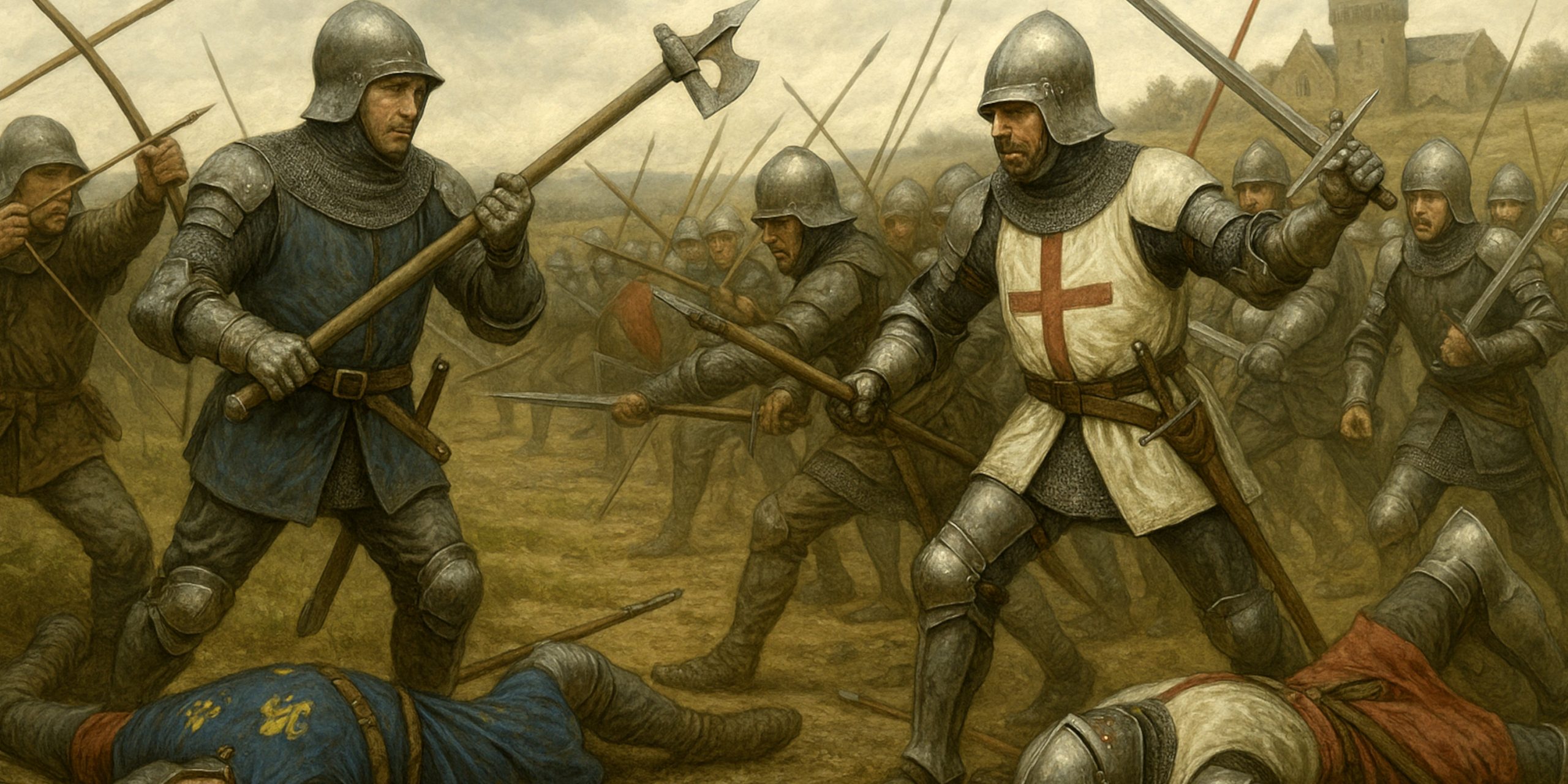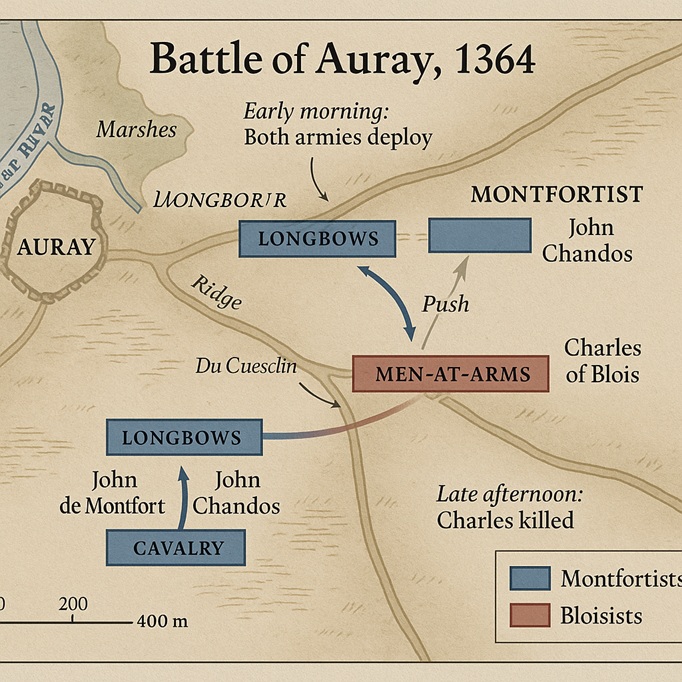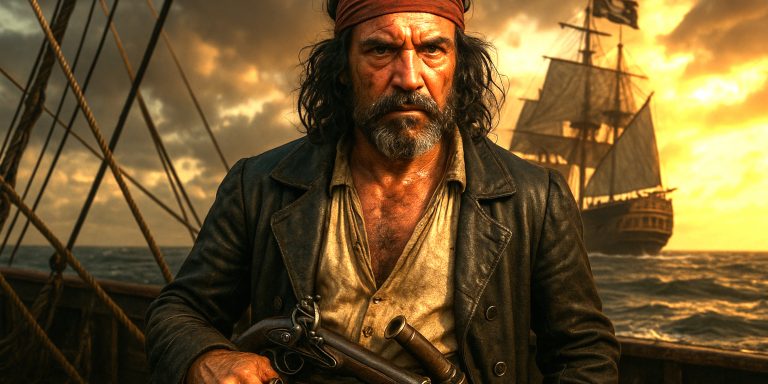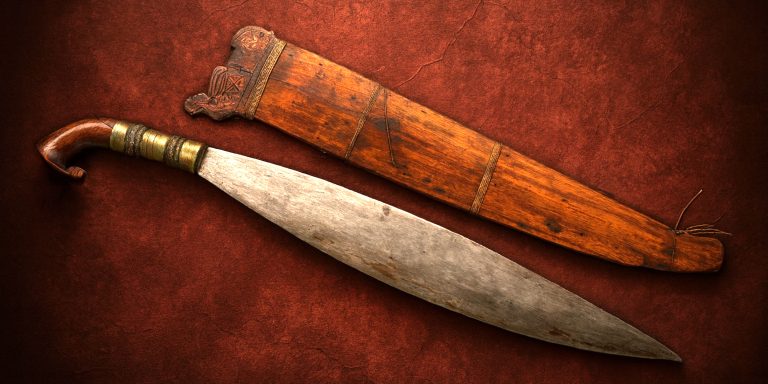
The Battle of Auray, fought on 29 September 1364, marked the decisive clash of the Breton War of Succession. This long conflict, which had seen Brittany divided between rival claimants and their powerful French and English allies, came to an end outside the town of Auray. The encounter was as much a dynastic struggle as it was part of the wider Hundred Years’ War.
Background
The war was sparked in 1341 after the death of Duke John III of Brittany, who left no direct heir. Two rival claimants emerged:
- Charles of Blois, supported by France and the Papacy.
- John of Montfort, supported by England.
For over two decades, the duchy was torn apart by campaigns, sieges, and raids. The death of Montfort’s father left his son, John IV, as claimant, guided by English allies and commanders. By 1364, both sides prepared for a decisive confrontation at Auray.
Forces
The battle involved well-balanced forces of knights, men-at-arms, and archers, reflecting the Anglo-French rivalry within Brittany.
Commanders
| Side | Commander | Allies |
|---|---|---|
| Montfortist | John de Montfort, assisted by Sir John Chandos (England) | English crown |
| Bloisist | Charles of Blois, assisted by Bertrand du Guesclin (France) | French crown |
Troop Composition (approximate)
| Side | Men-at-Arms | Archers | Cavalry | Total |
|---|---|---|---|---|
| Montfortist | 2,000 | 1,000 | 500 | 3,500 |
| Bloisist | 3,000 | 500 | 500 | 4,000 |
The Montfortist reliance on English longbowmen provided a tactical edge, while the Bloisist army fielded more heavily armoured men-at-arms under the leadership of Du Guesclin.
Arms and Armour
- Men-at-Arms: mail hauberks reinforced with plate elements, bascinets with visors, and large shields.
- Archers: English longbowmen equipped with yew bows, padded jacks, and daggers.
- Cavalry: armoured destriers with riders in plate harness, though cavalry charges played less of a role.
- Weaponry: swords, poleaxes, maces, lances, and longbows dominated the field.
The effectiveness of archery against armoured opponents was once again demonstrated at Auray, as at Crécy and Poitiers.
Sword Types Used at Auray
The Battle of Auray took place during the mid-14th century, a period of transition in European arms where armour was becoming more plate-dominated, and swords evolved to meet the challenge. Both the Montfortist and Bloisist forces fielded a variety of sword types, reflecting English, French, and Breton traditions.
Arming Swords
- The single-handed arming sword was still the most common knightly weapon of the period.
- Typically Oakeshott Type XIV and XV blades, with straight, double-edged forms designed for both cutting and thrusting.
- Lengths of 70–80 cm were common, with cruciform hilts and wheel or scent-stopper pommels.
- These swords were ideal for knights and men-at-arms fighting on foot in tight formations.
Longswords
- The growing prominence of Oakeshott Type XVa longswords is notable by the 1360s.
- With longer grips for two-handed use and narrower, tapered blades, these were effective against the increasing use of plate armour.
- English knights, particularly those fighting under Sir John Chandos, are likely to have favoured these weapons for their versatility in thrusting into gaps in armour.
Falchions
- The falchion, a single-edged cutting sword with a broad, heavy blade, was often carried by men-at-arms and archers.
- Examples from the mid-14th century include the Conyers Falchion and related designs with clipped points.
- These weapons excelled at delivering powerful chopping blows against lightly armoured opponents.
Daggers
- Knights and soldiers at Auray carried baselards and rondel daggers as sidearms.
- These were crucial for close fighting once an enemy was grappled to the ground, allowing thrusts into weak points in armour such as the armpit or visor slit.
- The rondel dagger in particular was a hallmark of the mid-14th century battlefield.
Associated Weapons
While swords were central, they were used alongside a range of polearms:
- Poleaxes with hammer, spike, and axe heads were increasingly popular for armoured combat.
- Spears and lances remained the principal weapons of mounted knights, though mounted charges were less decisive at Auray due to terrain and tactical deployment.
Distinctions Between Sides
- Montfortist/English troops: relied heavily on arming swords and longswords, supported by daggers and poleaxes. Archers often carried falchions as secondary weapons.
- Bloisist/French troops: more traditional emphasis on arming swords and shorter cutting swords, but commanders like Du Guesclin and their retainers would also have employed early longswords and daggers for plate-focused combat.
Archaeological Parallels
Although no complete swords from Auray survive, parallels exist:
- The Churburg Castle collection (Italy) contains Oakeshott Type XV swords dating from the mid-14th century.
- Finds from the Thames and Seine rivers also reflect blade styles consistent with those used at Auray.
- Contemporary effigies of Breton and French knights show cruciform arming swords with broad blades, and the increasing presence of longswords slung from belts.
The Battle

The Montfortist army, commanded tactically by Sir John Chandos, secured strong ground near Auray. The English archers were placed on the flanks, with men-at-arms holding the centre. Charles of Blois led his army in person, determined to settle the dispute.
The battle was fierce and prolonged. Du Guesclin fought bravely but was eventually captured. Charles of Blois was killed in the fighting, struck down amid his knights, and his death ended his claim to Brittany. John de Montfort was victorious, securing his ducal title with English backing.
Archaeology
Archaeological finds in the region around Auray are limited but have included scattered weapon fragments, arrowheads consistent with longbow use, and evidence of mass graves. Local traditions and battlefield surveys have identified probable zones of combat on the fields east of the town. The church of St. Goustan was later said to hold memorials to the dead of the battle.
Battle Timeline
- Early morning, 29 September 1364: Both armies array themselves outside Auray.
- Late morning: Montfortists anchor their line and deploy archers on the wings.
- Midday: Charles of Blois orders a frontal assault. Heavy fighting ensues.
- Afternoon: The archers break up French assaults; Du Guesclin is captured.
- Late afternoon: Charles of Blois is killed; the Bloisist army collapses.
- Evening: John de Montfort secures Auray and the Breton succession.
Contemporary Quotes
Jean Froissart, chronicler of the Hundred Years’ War, described the moment of Charles of Blois’s fall:
“And there was slain upon the place, fighting manfully, Charles of Blois, who would never yield nor ask for mercy.”
On the victory, he recorded:
“Thus ended the war of Brittany, and John of Montfort was thereafter called Duke of Brittany, and all the country obeyed him.”
Legacy
The Treaty of Guérande, signed the following year in 1365, confirmed John IV as Duke of Brittany. The battle secured English influence in the duchy, although John later sought balance between England and France. For France, the capture of Du Guesclin was a blow, though he was ransomed and returned to prominence. Auray remains a key example of how dynastic succession disputes became entwined with the wider Hundred Years’ War.
Watch the documentary:



